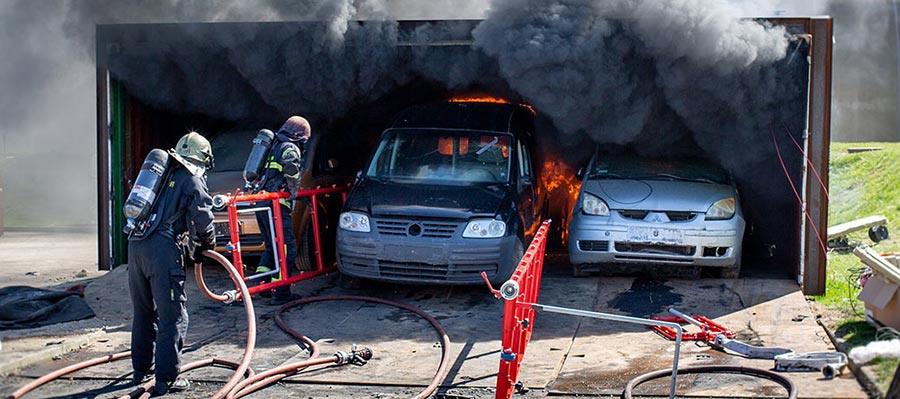Danish vehicle deck simulation testing offers new insight into lithium-ion fires
The Danish Institute of Fire and Security Technology (DBI) has conducted extensive testing of the effects of electric vehicle (EV) fires on ferry vehicle decks, to build up knowledge of how to bring these blazes under control. And, encouragingly, the result would appear to be an optimistic “we’ve got this”.
Using a simulated vehicle deck, consisting of 40’ containers with metal flooring and insulation on the ceiling, the DBI completed nine tests over the course of seven days, in which the battery packs inside three electric cars were deliberately short-circuited to create thermal runaway. The EVs comprised: a Renault Fluence Z.E. with a 22kWh battery; a Nissan Leaf with a 40kWh battery; and a Tesla Model 3 with a 75kWh battery – the latter two cars being “written off”, the DBI says.
“During each test, the electric car was surrounded by eight conventional cars,” says Alexander Kleiman, DBI project manager. “They were parked as close to each other as they would typically be on a ferry, to investigate the spread of the fire and reproduce the physical working conditions for the extinguishing work.”
Different firefighting methods were assessed, including sprinkling the battery with water mist, flooding the battery and using a traditional crew of PPE-clad firefighters with a fire hose.
“Manual firefighting was only initiated after about 10 minutes, to reflect the time that typically passes on the larger ferries from the time the fire is detected until the crew begins to extinguish the fire,” says Kleiman.
Following the tests, Kleiman’s verdict was that water mist proved “highly efficient – not to extinguish the fire, but to limit [its] spread, so that the crew can put out the fire using traditional extinguishing methods”. A fire tarpaulin was also used to enwrap one of the cars, acting as a large fire blanket. Although this contained the fire, the DBI observed that it would require a certain amount of space to deploy properly, which may rule it out for decks where vehicles are parked closely together.
The tests also enabled the DBI to fact-check a couple of assumptions about shipboard lithium-ion battery fires. Kleiman says there is “nothing to indicate” that the use of saltwater to extinguish these fires, or the fact that the crew are standing on a metal deck floor, make onboard firefighting procedures any more hazardous than extinguishing Li-ion battery fires on land. He adds: “Our tests indicate that the heat effect from the base of an electric car – which is where the battery pack is located – is not so severe that it damages the vehicle deck. When we removed the electric cars after extinguishing the fire, there was barely any visible trace on the plates that represented the floor of the vehicle deck.”
So, is the ferry sector ready to cope with an influx of EVs? Kleiman is generally upbeat on this score: while fire safety needs to be treated seriously, he is confident that the concerns surrounding onboard EV fires shouldn’t panic operators, personnel or passengers. He explains: “The battery pack in a new electric car is significantly more fireproof than in an old one. When we short-circuited the battery cells in the Renault Fluence, the whole battery caught fire. When we ignited it in a newer Tesla model 3, only the battery cell affected caught fire.
“Fires in electric cars aboard ferries are manageable, and not something we need to fear.”






